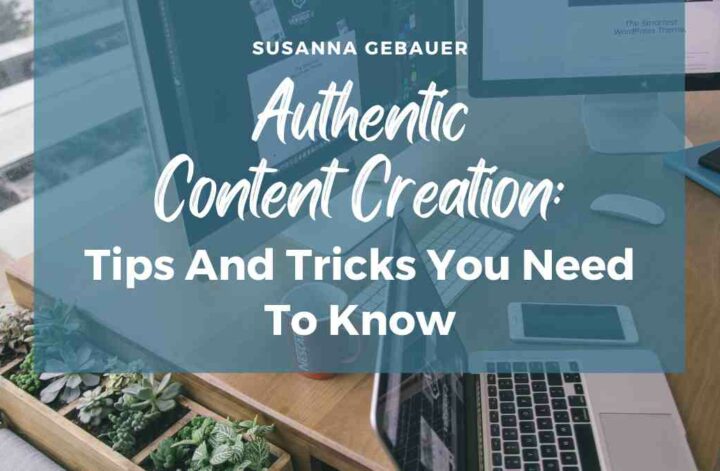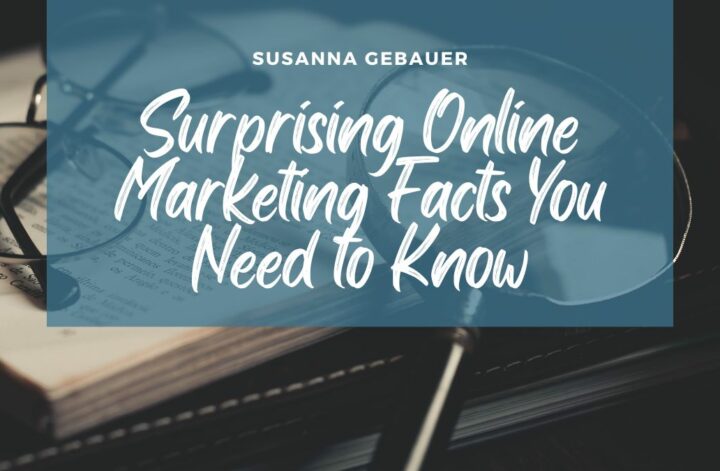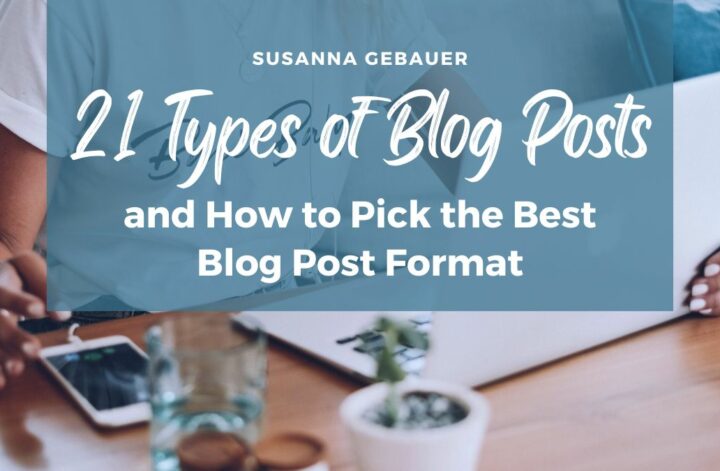When I started content creation for marketing, I just wrote. I created content packed with information and thought that would be enough. Little did I know about how to create great content, content that captures attention, builds a connection with my audience, plays with emotions, and finally converts readers into subscribers and customers.
I was unaware that the step from content to great content to grow a business is big and that it has not so much to do with being a better writer but more with knowing what to look for and what the keys to great content are.
Over the past decade, I learned along the way:
- from my guest blog hosts
- from studying what worked for others
- from analyzing what works for me
- from reading about great content
- from talking to content marketers
I am still learning. But I already know so much more about content creation than I knew when I started my blogging and content marketing journey that you can learn from my experience.
What you will learn in this guide:
- What is Content Creation
- Content Strategy – Creating content with a plan
- The point of view of your content creation
- Content Pillars: Strategic Content Creation
- Use the funnel approach
- Types of Blog Posts to Keep Your Content Fresh
- Let’s create content
- 10-Step Process to Creating Killer Content
- How to find Content Creation Ideas
- A Blogger’s Guide to Keyword Research
- Key components of a shareable blog post
- Maximizing blog traffic with compelling blog titles
- Unleashing the Power of Blog Post Images
- The Final Touch: Editing & Copywriting Secrets for Impactful Content
- Maximize content creation impact
- The Power of Evergreen Content: Marketing That Keeps Giving
- Unleash the Power of Old Blog Posts: Why and How to Update Your Content
- The power of repurposing
- Unleashing the power of digital storytelling in your content creation
- Understanding Storytelling
- Business Storytelling Frameworks
- The Power of Emotions in Content Creation
- Overcoming writer’s block: A guide for content creators
What is content creation?
Content creation is the process of making information accessible in various formats for specific audiences. This can involve:
- Writing: articles, blog posts, scripts, social media posts, etc.
- Visuals: photos, infographics, videos, presentations, etc.
- Audio: podcasts, music, voiceovers, etc.
The goal is to engage, inform, or entertain your audience, often to achieve a specific outcome like brand awareness, website traffic, email subscribers, or sales.
Not all content we can create is good content. This guide focuses on creating better, written content.
What good content is depends on your audience. Some content may be good for some people but not good enough for others.
Good content aligns with the goal of why it was created. Not all content can serve all purposes.
Creating good content hinges on several key elements:
- Knowing your audience: Understand their interests, needs, and preferences. Tailor your content to resonate with them.
- Value proposition: Offer something valuable, be it information, entertainment, a unique perspective, or solutions to their problems.
- Quality: Ensure accuracy, factual information, and clear, concise writing or production. Avoid errors and misinformation.
- Engagement: Capture attention with an interesting hook, use visuals effectively, and maintain a flow that encourages readers or viewers to continue.
- Originality: Stand out from the crowd. Offer a fresh perspective, insightful analysis, or unique storytelling.
- SEO optimization: If applicable, use relevant keywords and structure your content to be discoverable by search engines.
- Consistency: Publish regularly and maintain a consistent voice and style to build trust and audience loyalty.
- Measurement and adaptation: Track your content’s performance, analyze feedback, and adapt your approach to improve results.
If you focus on these aspects, you can consistently create content that resonates with your audience and achieves your desired goals. I will teach you how to get better at integrating these aspects into your content creation.
Content Strategy – Creating content with a plan
Before you jump into the content creation process think about some crucial aspects of your content strategy.
It is never “just” about creating content. You need a purpose for your content or your content will not bring you results.
Content creation goals
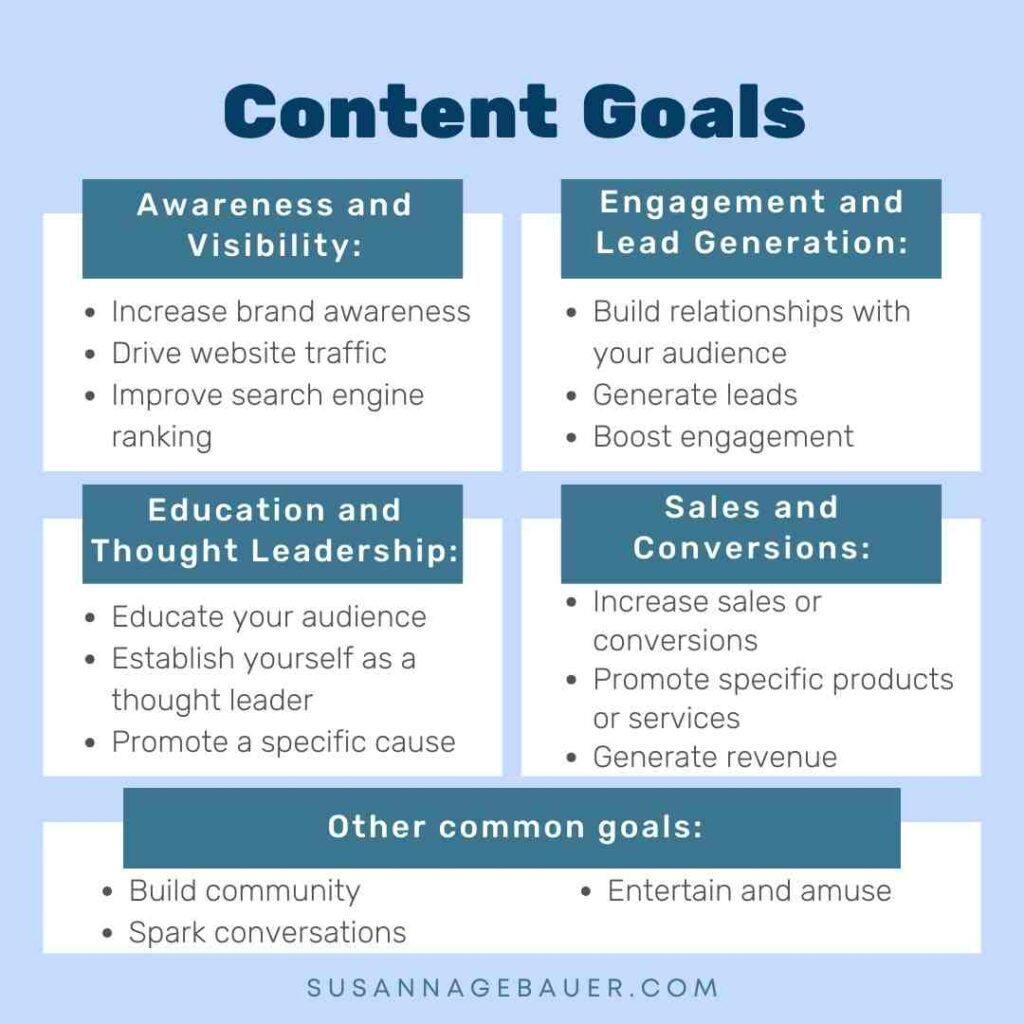
What do you want to achieve with your content? There are overall content marketing goals, and there are goals for each piece of content. Think about your content goal before you start creating content. If you don’t know the why, your content will not contribute to reaching the results (that you don’t even know.)
Content creation goals can vary widely depending on the individual or organization creating the content. However, there are some common goals that many share:
Awareness and Visibility:
- Increase brand awareness: Make people aware of your brand, product, or service.
- Drive website traffic: Attract more visitors to your website or landing page.
- Improve search engine ranking: Increase visibility in search results to gain organic traffic.
Engagement and Lead Generation:
- Build relationships with your audience: Foster trust and loyalty with potential customers.
- Generate leads: Capture contact information of interested individuals for further marketing efforts.
- Boost engagement: Encourage interaction with your content through comments, shares, or other actions.
Education and Thought Leadership:
- Educate your audience: Provide valuable information and solve their problems.
- Establish yourself as a thought leader: Share your expertise and insights to build authority.
- Promote a specific cause or movement: Raise awareness and encourage action on an important issue.
Sales and Conversions:
- Increase sales or conversions: Drive direct sales or actions like sign-ups or downloads.
- Promote specific products or services: Highlight the benefits of your offerings.
- Generate revenue through advertising or affiliate marketing: Utilize content to monetize your audience.
Other common goals:
- Build community: Create a space for people to connect and share interests.
- Spark conversations: Encourage dialogue and debate on important topics.
- Entertain and amuse: Provide enjoyment and lighthearted content.
Remember: It’s crucial to align your content creation goals with your overall business objectives and target audience. Choose goals that are measurable and achievable to track your progress and adapt your strategy as needed.
The goals you have for a piece of content, influence the content creation. Keep in mind why you are creating this piece of content and make sure this content can achieve your goal:
- If you want to get traffic from Google search, you need to find keywords for your content you can rank for.
- If you want to get traffic from social media, you want to consider content like expert roundups or ask experts for quotes you can add to your content. The experts will help you share your content.
- If you are after signups for your newsletter, you need a matching lead magnet that you can offer in your content to get signups.
- If your goal is to sell a product, you need a story that will make people buy your product.
Do you see where this is going? Every goal or purpose has an impact on your content. If your content does not have a purpose it may be great and entertaining content but will often fail because it will not actively work toward achieving its goals.
The point of view of your content creation
Which point of view should you choose for your content?
The answer is simple: Yours.
For years, I have created fact-based content with a focus on providing as much value and facts as possible. My content was neutral and could have been created by any person with the knowledge.
People consumed my content. But I struggled to build a brand and a community around my content. Results were not what I had expected.
Why? Because facts and information compete with other information about similar topics.
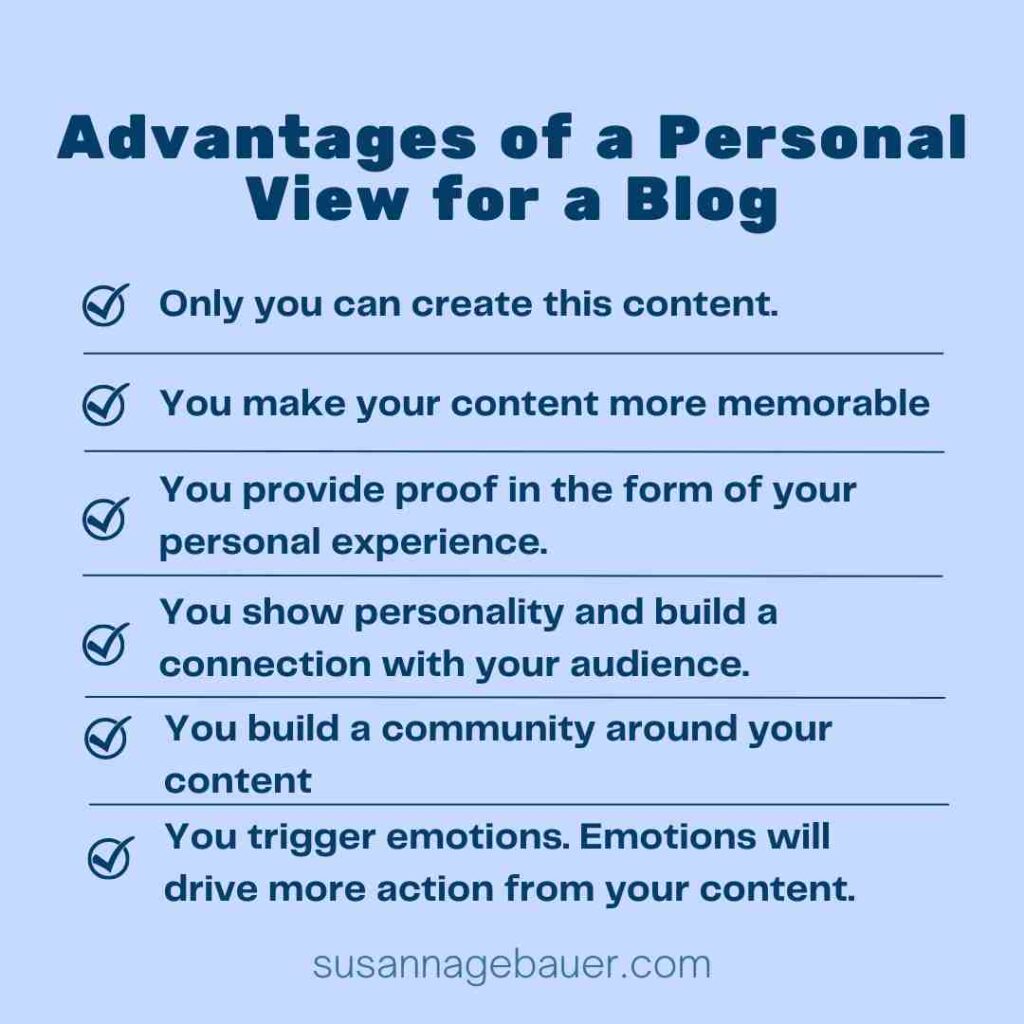
People take the advice and the facts and move on. But they don’t remember where they found the information and who provided it.
The result?
You provide value and invest a lot of time and effort in your content creation but you will have a hard time getting much out of it. Because people don’t remember that it was you who helped them and they failed to get to know YOU through your content.
Adding a personal viewpoint, a story, or results you created by applying the facts turns your content into something very personal.
- Only you can create this content.
- You make your content more memorable – because it stands out from other fact-based content.
- You provide proof in the form of your personal experience.
- You show personality and build a more personal connection with your audience.
- You build a community around your content because people feel that they know you.
- You trigger emotions in your content. Emotions will drive more action from your content.
But what if you are marketing a business? How can you be more personal with your content?
A business has personal stories to share, too. Here are some ideas:
- Give some behind-the-scenes.
- Tell customer stories and how you helped your customers.
- Talk about your results when applying the facts you are talking about.
- Interview a customer.
- How did your business evolve?
The competition for content is fierce. The best way to stand out is to create content that has more than value and facts: Personality and a story.
Content Pillars: Strategic Content Creation
Are you struggling to keep up with the content creation demands? You’re not alone. Enter content pillars: a strategic approach that gives each piece of content additional purpose and aligns them for maximum impact.
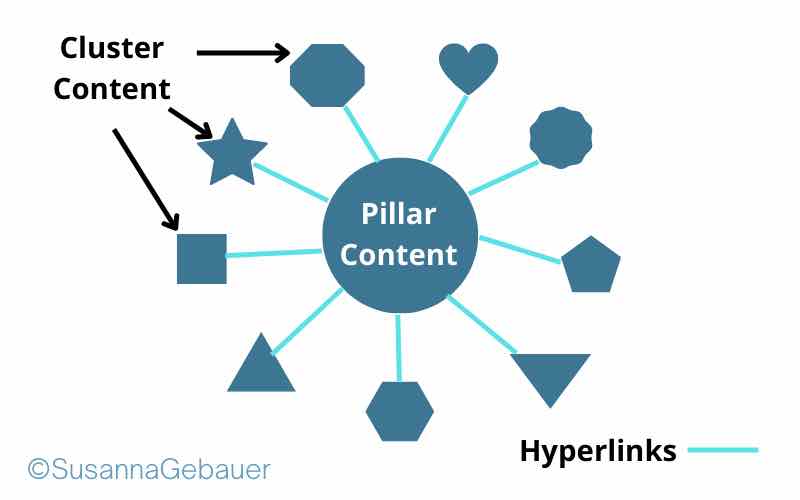
Imagine that each blog post and each piece of your content contributes to your overall branding and authority. Each cluster piece strengthens your pillar content, driving targeted signups and conversions. Sounds good, right?
What are Content Pillars?
Think of your pillar content as your expertise cornerstones. Other content pieces link to these pillars to emphasize their importance – these other content pieces are called cluster content.
Instead of covering random topics, focus on a few chosen fields and build content clusters around them. This showcases your authority and attracts the right audience.
Do you need an example?
Consider that you are creating a blog about trail running. Your content pillars could be running equipment and training for trail running. Cluster content could cover the different types of equipment from shoes to backpacks that all point to a pillar piece that lists all the gear you need for a run out in nature. The cluster pieces for the training could be core training, different running exercises and more pointing to a training plan as pillar content.
Content Pillars help you to stand out on social media and be recognized in your field of expertise as they help you stick to a niche and topic and build your audience and reputation for it.
- Craft posts that reinforce your chosen pillars. The majority of your social media posts should be about your content pillars – your cluster content will provide you with endless ideas
- Engage in conversations, connect with relevant accounts that post around your content pillars, and maintain a consistent brand voice.

Content pillars have the power to boost search traffic:
- Content pillars provide structure and context for search engines.
- Cluster content interlinks and points to the pillar page, helping Google understand your content and rank it higher.
Pillar Pages serve as cornerstone content on your blog and naturally stand out:
- They can be used as central hubs summarizing your pillar topic.
- Use them to capture targeted leads and conversions through email signups or direct sales.
Do you need an example? You are on a pillar page right now. This guide to content creation is a pillar of my blog. Many blog posts about various aspects of content creation point to this page.
How to build content clusters with your content creation process:
If you already have multiple pieces of content on your blog, you can regroup them via links and restructure your blog into content clusters:
- Analyze your existing content, choose pillar topics, and decide if you have content that can serve as pillar content.
- Group existing blog posts into relevant pillars and cluster content.
- If necessary, create a pillar page summarizing the topic and linking from the cluster content to the pillar page.
Plan New Content:
- Identify 2-6 pillar topics relevant to your audience – I would start with two pillars and add to them as your audience and your content base grows.
- Brainstorm 20+ cluster content ideas for each pillar.
- Prioritize the cluster content and fill your content calendar for the next months with the cluster and pillar content ideas.
- Start creating content.
- Make sure you link from each cluster piece to the pillar page.
Integrate content pillars into your content creation:
Transform your content creation from random posts to a strategic powerhouse. Creating content that fits into your content pillars will attract the right audience, build authority, and boost your blog’s success with targeted content pillars.
Here’s how to effectively utilize content pillars:
- Identify Core Topics: Start by identifying 3-5 core topics that are central to your brand or business. These topics should resonate with your target audience and reflect your expertise.
- Create Pillar Content: Develop high-quality, comprehensive content pieces for each pillar. These can be in the form of blog posts, videos, podcasts, or infographics. Ensure that your pillar content provides value and addresses the needs and interests of your audience.
- Diversify Content Formats: Repurpose your pillar content into various formats to cater to different audience preferences. For example, you can turn a blog post into a video tutorial or an infographic for social media.
- Plan Content Calendar: Establish a content calendar that outlines when you’ll create and publish content for each pillar. This helps you maintain consistency and avoid last-minute scrambling for ideas.
- Interlink Content: Strategically interlink content pieces within the same pillar to encourage exploration and keep visitors engaged on your website or platform. This also improves SEO by signaling to search engines the relevance and depth of your content.
- Monitor Performance: Regularly monitor the performance of your pillar content to identify what resonates best with your audience. Use analytics tools to track metrics such as page views, engagement, and conversions.
- Adjust and Iterate: Based on performance insights, refine your content strategy as needed. This may involve tweaking your content topics, formats, or distribution channels to better align with audience preferences and business objectives.
By implementing content pillars effectively, you can streamline your content creation process, enhance brand consistency, and drive engagement and conversions with your target audience.
Stop wasting time with content creation: Use the funnel approach
Creating content takes time and effort. But what if you could streamline the process and create content that gives results? The answer is to use the funnel approach.
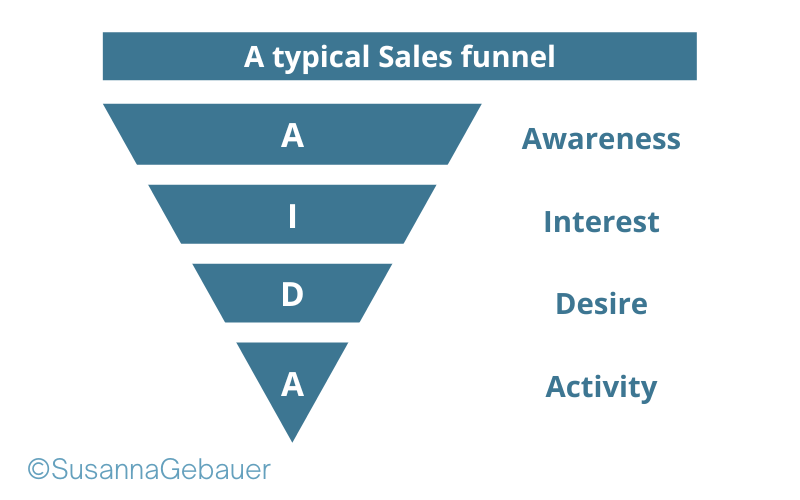
The funnel approach involves creating content for each stage of the marketing funnel: awareness, interest, decision, and action. By matching your content to the stage a customer is in, you can increase your chances of converting them into a customer.
Here are some tips for creating content for each stage of the funnel:
- Awareness: Create content that educates potential customers. Content in the awareness phase is more about the problems you are solving for your customers than your products. Awareness content could include blog posts, infographics, or videos.
- Interest: The purpose of the content in this phase is to build authority, trust, and a connection with your audience. Good content in this phase is email newsletters, case studies, and customer testimonials. In this phase you want your content to be close to the topic of the problem your product solves.
- Decision: At this stage, potential customers are comparing different options. Create content that helps them see why your product or service is the best choice and why they can trust you. In this phase, testimonials, feature comparisons, demos, free samples, and success stories are great content options.
- Action: Finally, you need to encourage potential customers to take action. Create content that makes it easy for them to do so, such as free trials, coupons, or limited-time offers.
By using the funnel approach, you can create content that is targeted, relevant, and effective. This will help you save time and money as you need fewer content pieces, and ultimately, convert more leads into customers.
Types of Blog Posts to Keep Your Content Fresh
Not every blog post or content piece follows the same format. Understanding different types of blog posts can help you keep your blog fresh, interesting, and appealing to your readers.
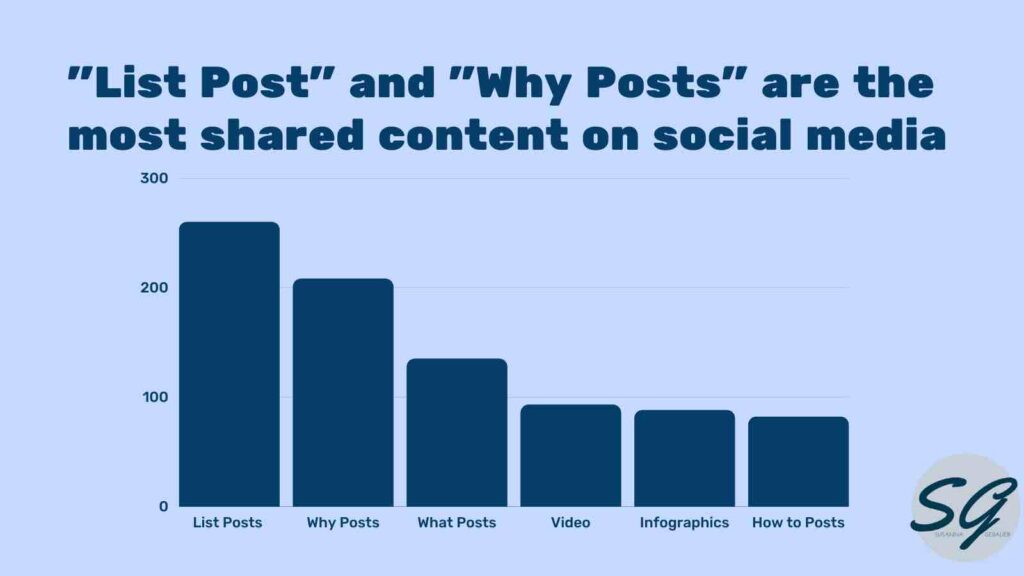
- Know your audience: Different types of posts appeal to different audiences. Consider your readers’ interests and needs when choosing a format.
- Know your distribution: Some types of posts work best in some channels. Other types of blog posts are great to be repurposed into social media posts. Keep in mind how you want to distribute your content when you choose your types of blog content.
- Mix it up: Don’t get stuck in a rut! Experiment with different types of posts to keep your content fresh and engaging.
Here are some types of blog posts you should know and consider for your content:
- List posts or listicles
- How-to Guides and Tutorials
- Why type of blog post
- What-is posts
- Pillar Content / Content Hubs
- News posts and current events
- Newsjack posts
- Controversial subjects and discussion posts
- Checklist posts
- Case Studies
- Interview posts
- Review and comparison posts
- Expert roundup posts
- Curated posts
- Problem solution posts
- Questions and answers posts
- Rant posts or funny stories
- Beginners guides
- Myths debunking posts
- Personal stories posts
- The infographic post
Sometimes it is not clear what type of content a blog post is. It makes sense to combine some of the above types in one post.
Let’s create content
After all these preliminary thoughts, it is time to start creating the content!
10-Step Process to Creating Killer Content
A content creation process helps to ensure that you don’t forget crucial steps in your content development. It also helps you to be more efficient by doing each step at the optimal time.
Here is a simple 10-step process for creating content that gets results:
- Find a content idea: Brainstorm potential topics that are relevant to your audience and niche.
- Question the idea: Is this topic interesting to my audience? Is it something they’ve been asking about? Is it timely and relevant?
- Keyword research: Use keyword research tools to identify relevant keywords that your target audience is searching for. This will help you optimize your content for search engines and attract more organic traffic.
- Additional content to stand out: What can you do to make your content stand out from the competition? Consider adding unique insights, data, or case studies.
- Create Headlines to Win: Write a catchy headline that grabs attention and accurately reflects your content.
- Start with an outline for your post: Organize your thoughts and ensure your content flows logically.
- Fill each section of the content: Write clear, concise, and engaging copy. Use visuals, infographics, and videos to break up your text and make your content more visually appealing.
- Plan your distribution: Where will you share your content? Promote your content on social media, email marketing, and other channels.
- Add a call to action: Tell your readers what you want them to do next, whether it’s subscribing to your blog, visiting your website, or making a purchase.
- Finish up your content creation process: Proofread your content carefully and make sure it is free of errors. Optimize your content for search engines. Publish your content and start promoting it!
By following these steps, you can create content that informs, engages, and converts your audience.
Let’s go into more detail:

How to find Content Creation Ideas
Many bloggers face the challenge of brainstorming new and engaging topics to write about. Fortunately, there are several quick and effective methods you can use to find inspiration for your blog content.
Here are 40 tips to help you generate blog post ideas:
- Ask your audience
- Consider what others post
- Keep your mind open in conversations
- Find interesting Reddit threads
- Search for questions in a subreddit
- Search for relevant questions on Quora
- Curate answers to interesting questions on Quora
- Listen to your customers
- Ask your customers
- Ask your email subscribers
- Check your blog comments
- What are blogs from your niche covering?
- What are blogs from your niche NOT covering?
- Check comments on competitors’ blogs
- Check competitors’ social media
- Interview experts from your niche
- Create expert roundups
- Share your point of view: What you learned
- Share your point of view: How you failed and how to do better
- Share your point of view: Where you found the advice
- Share your point of view: Who helped you
- Share behind-the-scenes
- Create a case study from your experience
- Update existing blog posts
- Check your pillar pages: what cluster content is missing?
- Create the opposite of what you already have
- Use Google search: Autocomplete
- Use Google search: Keyword suggestions
- Use Google search: Search results
- Use Google search: Recent news from your niche
- Use keyword tools: Answer the public
- Use keyword tools: Ubersuggest
- Use keyword tools: Semrush
- Use keyword tools: Google Keyword Planner
- Use keyword tools: Buzzsumo
- Create roundup posts
- Create Tools lists
- Make resources lists
- Create facts and data collections
- Use a blog post ideas generator
Make sure you have a place where you can store content ideas. Write down the ideas as you have them. I have lost great ideas more than once, simply because I did not write them down the minute I had them.
Whenever you are in need of a fresh content idea, you can choose from your list of ideas.
A blogger’s guide to keyword research
Please note: This is not an SEO guide to keyword research. This is for a blogger who does not focus on search engines. Instead, this is for a blogger who writes content for their audience and still wants to have a chance to get some traffic from Google search.
I don’t run a blog focused on search traffic. I don’t create content for SEO purposes. Instead, I write for people: You.
But that does not mean I want to miss out on the opportunity of getting traffic from Google search for free.
You can only get traffic from search engines if your content shows up in the search results for a keyword or phrase that people search for. That means you need to figure out what people could be looking for when your content is the answer: Keyword research.
Keyword research is not all about search engines. It is also about using the words that the people looking for your content are using.
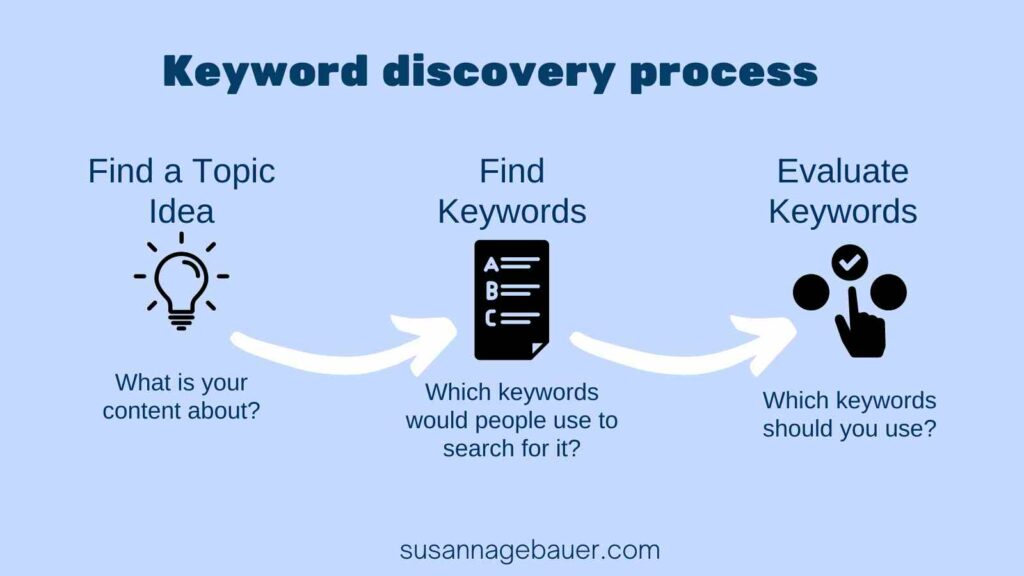
Brainstorm relevant keywords
I usually start with a mix of idea and keyword brainstorming. If I have a vague idea for a topic I want to cover, I play around with related keywords, use tools to get an idea of how competitive the topic is, put some keywords into Google and see what kind of results I get.
The goal is to get a feeling for the topic:
- Is there a chance to rank for it?
- What questions do people have when looking for this topic?
- What does existing content cover about this topic?
Then I start collecting keywords around the topic:
- I start with a main keyword and use tools to get more ideas for keywords and phrases that people search for in relation to the topic. I put my keyword into “Answer the Public” and Google search to find questions and search ideas.
- For some keyword ideas you now want to get an idea, how competitive these keywords are. I use “SEMrush,” and “Ubersuggest” to get search volume and keyword difficulty. These tools also give me more ideas for related keywords.
- Now, I choose which of the keywords on my list I want to use in my content. Usually, some of the keyphrases will make subsections in the content.
- From the chosen keywords, I now choose one keyword that I am going to use as the focus keyphrase for the content.
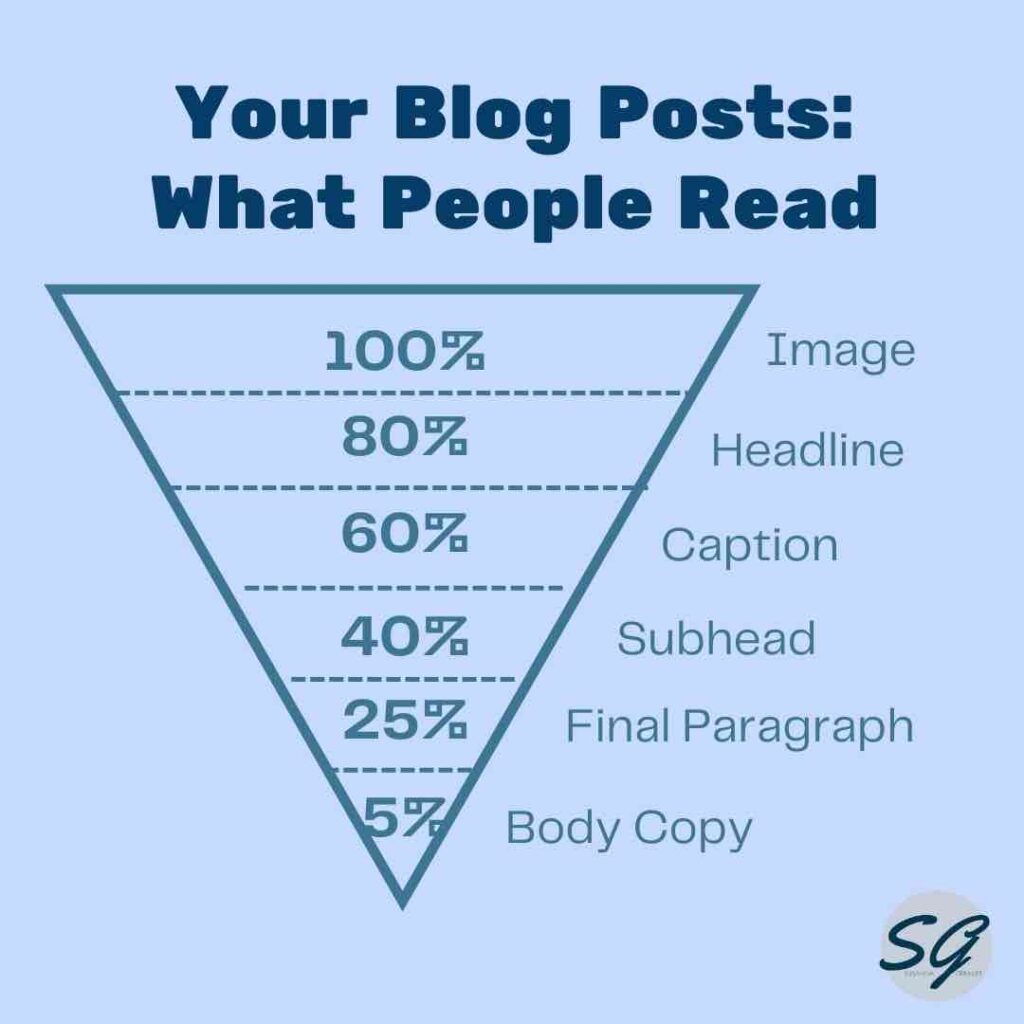
Key components of a shareable blog post
Crafting blog posts that resonate with your audience and attract attention from search engines and social media requires careful consideration of various elements. If you focus too much on the body text and neglect the other structural elements, you will be missing out!
Here are 13 crucial components to enhance the shareability and likability of your blog posts:
- Clear Blog Topic: Choose topics that stand out and offer a unique perspective or angle, ensuring your post adds value beyond existing content.
- Topic Audience Fit: Align your topics with your target audience’s interests and needs, ensuring relevance and potential to drive engagement and conversions.
- Inject Your Personality: Infuse your posts with your unique voice and personality to foster connections and resonate with your audience.
- Substantial Content: Provide valuable insights and information, avoiding superficial content that fails to engage or inform your readers effectively.
- Purposeful Content Creation: Every post should serve a clear purpose, whether it’s driving traffic, generating leads, or providing valuable information to your audience.
- Audience Benefit: Communicate the benefits readers will gain from your post, offering actionable tips, insights, or exclusive content.
- Compelling Blog Headline: Craft attention-grabbing headlines that resonate with your audience and encourage clicks, using power words and curiosity to pique interest.
- Strategic Header Image: Select captivating header images that complement your content and entice clicks when shared on social media platforms.
- Structured Body Content: Organize your content with clear paragraphs, subheadings, and bullet lists to improve readability and engagement.
- On-topic First Sentence: Capture readers’ attention immediately with a clear and concise opening sentence that sets the tone and topic of your post.
- Grammar and Spelling: Ensure your content is free from grammatical and spelling errors, enhancing professionalism and readability.
- Strategic Use of Images: Include relevant images throughout your post to aid comprehension, enhance visual appeal, and improve search engine visibility.
- Optimized Captions/Meta Descriptions: Craft compelling meta descriptions that entice clicks in search engine results and social media previews, maximizing your post’s visibility and click-through rate.
By incorporating these components into your blog post creation process, you can increase the likelihood of attracting and engaging your audience while optimizing your content for search and social media platforms.
Remember, each element plays a vital role in enhancing the overall effectiveness and shareability of your blog posts.
Since some elements are so important, I will dive deeper into them in the following chapters!
Maximizing blog traffic with compelling blog titles
Your blog titles wield immense power in driving traffic and bolstering your blogging success. When your posts are shared on social media or appear in Google search listings, it’s your title that grabs attention and compels users to click through to your content.
Consider this: Your blog title is the first impression readers have of your post. It’s what entices them to explore further. Neglecting your blog titles is akin to ignoring a crucial aspect of your content strategy.

Here’s why your blog titles matter:
- First Impressions Count: Whether on social media feeds or search engine results, your blog title is often the sole factor determining whether users engage with your content. It’s your chance to make a compelling first impression.
- Precede Content Creation: Crafting a killer blog headline upfront can guide your content creation process. Rather than creating content and then struggling to fit a headline, starting with a captivating title ensures your content fulfills the promise made in the headline.
- Resonate with Audiences: Certain headline types resonate well, particularly on social media platforms. Types like list posts, why posts, and how-to posts often garner more social shares, engaging audiences with valuable insights and actionable tips.
To write better blog titles, consider these tips:
- Be Clear and Specific: Convey what your post is about without leaving readers guessing. Specificity adds clarity and intrigue, compelling readers to learn more.
- Promise Value and Deliver: Ensure your title promises something valuable to your audience, and then deliver on that promise within your content. Value-driven titles encourage clicks and engagement.
- Invoke Curiosity and Trust: Use curiosity-inducing words or challenge common beliefs to spark interest. However, ensure your titles maintain trustworthiness and relevance to your content.
- Experiment and Analyze: Utilize headline analyzer tools or generate multiple headlines to find the most effective option for your content. Testing and iterating can help refine your headline-writing skills over time.
Remember, your blog titles are invaluable assets in driving traffic and engagement to your content. By investing time and effort into crafting compelling titles, you set yourself up for greater blogging success and audience reach.
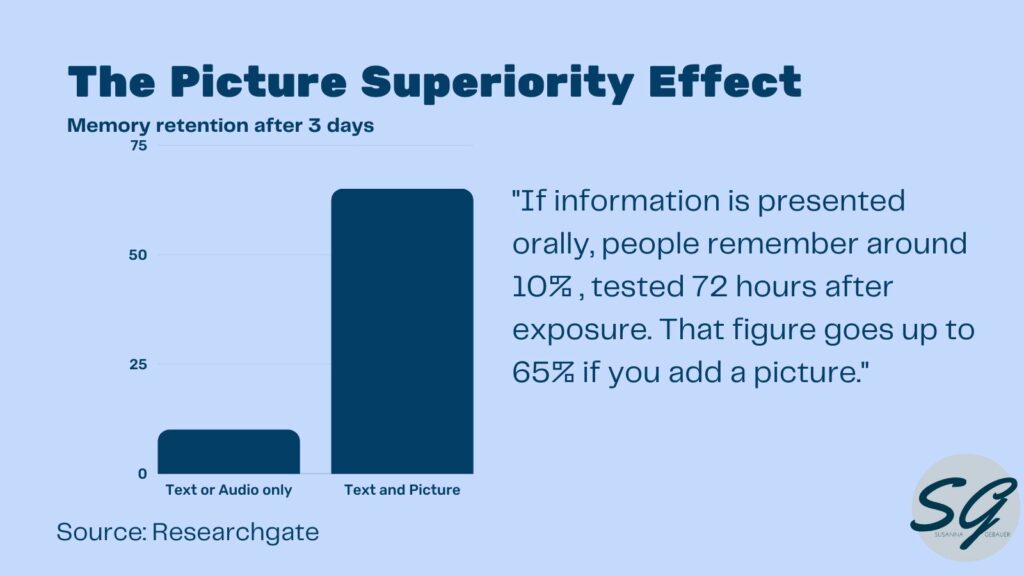
Unleashing the Power of Blog Post Images
Human brains retain 65% of the information presented as images, compared to 10% with text alone. This is called the Picture Superiority Effect.
It means that meaningful images make people remember your blog post better and enhance blog post recall and engagement, making them essential for blogging success.
There are more benefits of blog images:
- Capture attention and enhance readability, keeping readers engaged.
- Aid learning and retention of complex concepts, boosting audience understanding.
- Improve SEO and increase social media shares, extending post reach and visibility.
But what kind of blog images will bring these benefits – let me tell you a secret: plain stock images will not do the trick!
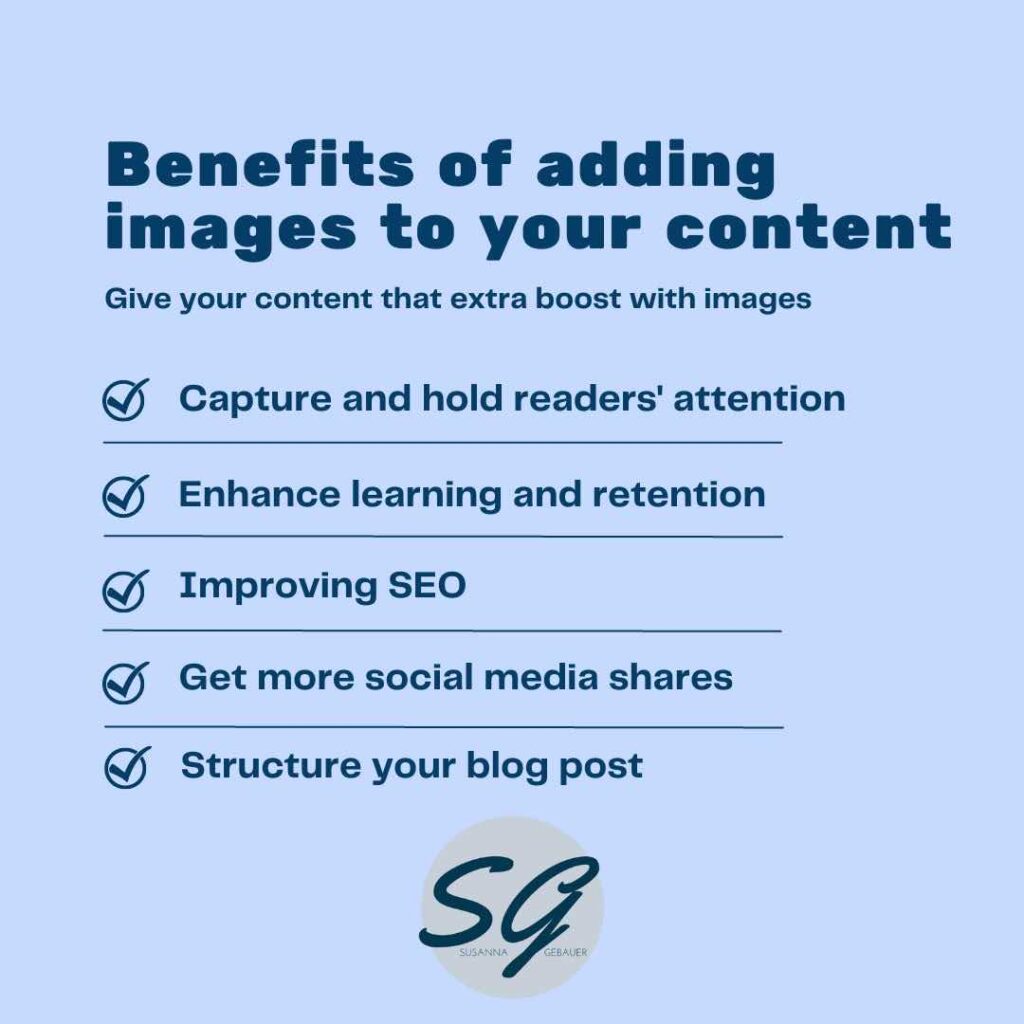
How to obtain blog images:
- Shoot your photographs for personalized content.
- Hire a graphic designer for professional visuals, albeit with time constraints.
- Use stock photos cautiously, as they may lack uniqueness and marketing power.
- Utilize other bloggers’ images with proper attribution and permissions.
- Create your visuals using design apps like Canva for branding and versatility.
You can use images you can find on the Internet if you follow copyright rules. You can also create images where you possess copyright. Which is better and why?
- Creating images offers branding opportunities and SEO benefits, but requires time and design skills.
- Found images are quicker but lack marketing power unless properly cited and utilized.
Generally, creating your own images will help to utilize the full power of blog images.
What types of blog images are there?
Consider graphics, photos, illustrations, infographics, charts, diagrams, screenshots, thumbnails, memes, GIFs, quote images, presentations, and videos based on content and creative skills.
Visuals can come in many forms, formats, and file sizes. But you need to optimize for the social media platforms you are using and consider page load times by adhering to image size and file size requirements.
Importance of Image ALT Tags:
- Describe images with keyword-rich ALT tags for search engine indexing and ranking.
- Use .png or .jpeg formats, incorporate keywords in file names, and consider folder structure for image SEO.
Don’t overlook the potential of blog post images in enhancing engagement, SEO, and audience retention. Mastering the art of selecting, creating, and optimizing images can significantly elevate your blogging success.
The Final Touch: Editing & Copywriting Secrets for Impactful Content
Editing is like eating a three-course meal.
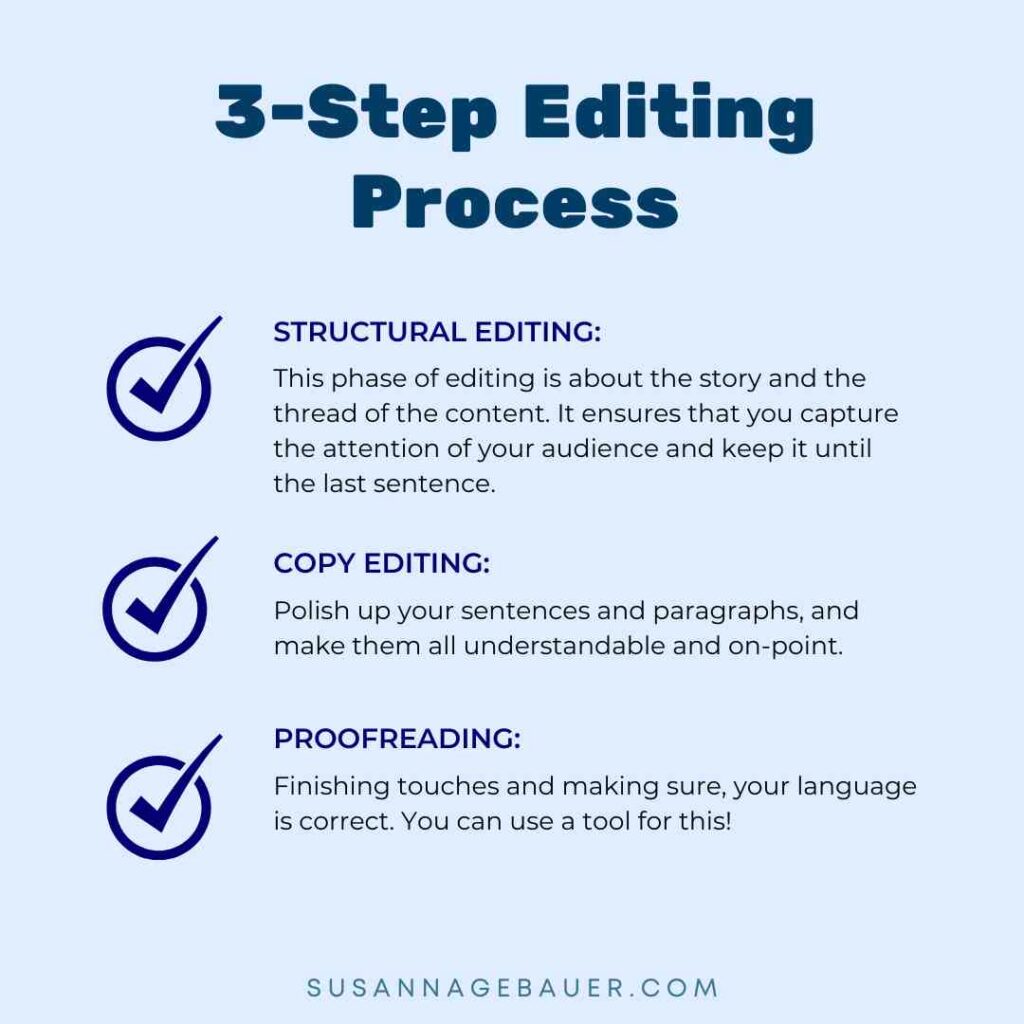
You have probably always done a bit of every course of that meal. But editing becomes a lot more efficient if you do the editing for each type at a time and don’t mix them up.
- Structural Editing: This phase of editing is about the story and the thread of the content. It ensures that you capture the attention of your audience and keep it until the last sentence.
- Copy Editing: Polish up your sentences and paragraphs, and make them all understandable and on-point.
- Proofreading: Finishing touches and making sure, your language is correct. You can use a tool for this!
Let’s take a closer look at what you need to do in each phase of your editing process:
Structural Editing
This editing phase is about the big picture of your content.
Editing is not just about writing correct sentences and better grammar. There is more to editing than optimizing each sentence for better reading and understanding.
It is also about checking the (almost) finished piece for a consistent thread your audience can follow. Read it from beginning to end to see if the story pulls the readers in and guides them through to the final sentence.
Within structural editing, you want to answer questions like the following:
- Does the content match up to the promise you make in the headline? Consider adding what is missing – or even changing the headline to make it match the content.
- Are all sections necessary and packed with information? Consider cutting unnecessary filler stuff and avoid redundancy.
- Is the information easy to understand?
- Do you use examples where they help?
- Do you provide proof for the claims you make? Use data, experience, case studies, quotes, or links to provide proof.
Make it clear!
Keep in mind that editing is about adding value to your content. Sometimes that is about adding an explanation and often it is about cutting unnecessary filler words. But it is not about coming up with the shortest version of your text, it is about the most valuable one.
Copy Editing:
Ask yourself: What do I mean by this? Don’t write generic content that keeps your audience guessing what you mean.
- Avoid filler content.
- Vary your sentence structure.
- Focus on active voice.
- Provide proof for claims that you make in your content.
- Avoid redundancy (Repeated words and repeated information)
Do sentences and paragraphs follow a natural flow in your arguments? If not, re-arrange and rewrite to make everything come naturally.
Proofreading:
This third stage of editing is all about correct grammar and spelling.
I tend to be blind when it comes to finding all spelling mistakes and since I am German and English is not my native language I appreciate the help of a tool for proofreading and polishing up my grammar.
I use Grammarly, even the free version allows you to find the most important bugs in my writing.
If you have the option, I also recommend that you have a second person read your content before you publish. This will help you discover the last sentences that are hard to read or sound strange.
However, there are some things you should look out for when you finalize your content:
- Simplify text – Grammarly will also help you with this. It will mark the long and complex sentences and give you a simplified suggestion.
- Ignore Grammarly suggestions when they don’t make sense – yes, that happens
- Take a break. Let your content sit for a day or two. Now read it again with a fresh mind. Correct everything you find.
Maximize content creation impact
The Power of Evergreen Content: Marketing That Keeps Giving
In today’s fast-paced world, it’s easy for content to become outdated quickly. But what if you could create content that stays relevant for months, even years, to come? That’s the power of evergreen content.
Evergreen content is content that is timeless and doesn’t get old quickly. This is in contrast to news content that has a peak interest in the beginning but that interest dies off very fast.
It’s the kind of content that you can keep promoting and sharing over and over again, without having to worry about it becoming irrelevant.

Why is evergreen content so crucial for marketing?
There are many reasons why evergreen content is a valuable tool for marketers. Here are a few:
- It attracts organic traffic: As search rankings for a pice of content build up over time, evergreen content is more likely to rank higher in search engine results pages (SERPs), which means it’s more likely to be seen by potential customers.
- It builds trust and credibility: By providing valuable and informative content, you can establish yourself as an expert in your field and build trust with your audience.
- It saves you time and money: Once you’ve created a piece of evergreen content, you can continue to promote it and share it for months or even years to come. This saves you time and money that you would otherwise have to spend on creating new content.
How to create evergreen content:
Creating evergreen content is not as difficult as it may seem. Here are a few tips:
- Choose timeless topics: Focus on topics that are always relevant to your audience, such as how-to guides, ultimate guides, and listicles.
- Create high-quality content: Make sure your content is well-written, informative, and visually appealing.
- Update your content regularly: Even evergreen content can benefit from an occasional update. Make sure to keep your content fresh by adding new information and examples.
By creating evergreen content, you can create a marketing strategy that keeps giving, even long after you’ve hit publish.
Unleash the Power of Old Blog Posts: Why and How to Update Your Content
In the ever-evolving landscape of online content, many entrepreneurs and businesses overlook a valuable resource hidden within their website: old blog posts. Refreshing and updating old content can be more efficient and effective than constantly churning out new articles. Your existing content can be a lot more valuable than creating new content.
Here’s why you should consider breathing new life into your old blog posts and how to do it effectively.
Why Update Old Blog Posts?
Relevance:
Over time, facts change, data becomes outdated, and new trends emerge. What was once comprehensive and well-researched may now appear outdated and irrelevant to your audience.
SEO Benefits:
Google favors fresh content, and updated blog posts have a better chance of ranking higher in search results. Freshening up your content can improve click-through rates and overall search performance.
Enhanced User Experience:
Providing your audience with up-to-date, valuable content builds trust and loyalty. Refreshed blog posts demonstrate your commitment to delivering the best information available.
How to Update Old Blog Posts
There are different ways to update old content. It is not always about outdated facts. Sometimes you have more insight and knowledge you can share or new best practices you learned. Here is how to create perfect new content from your existing content:
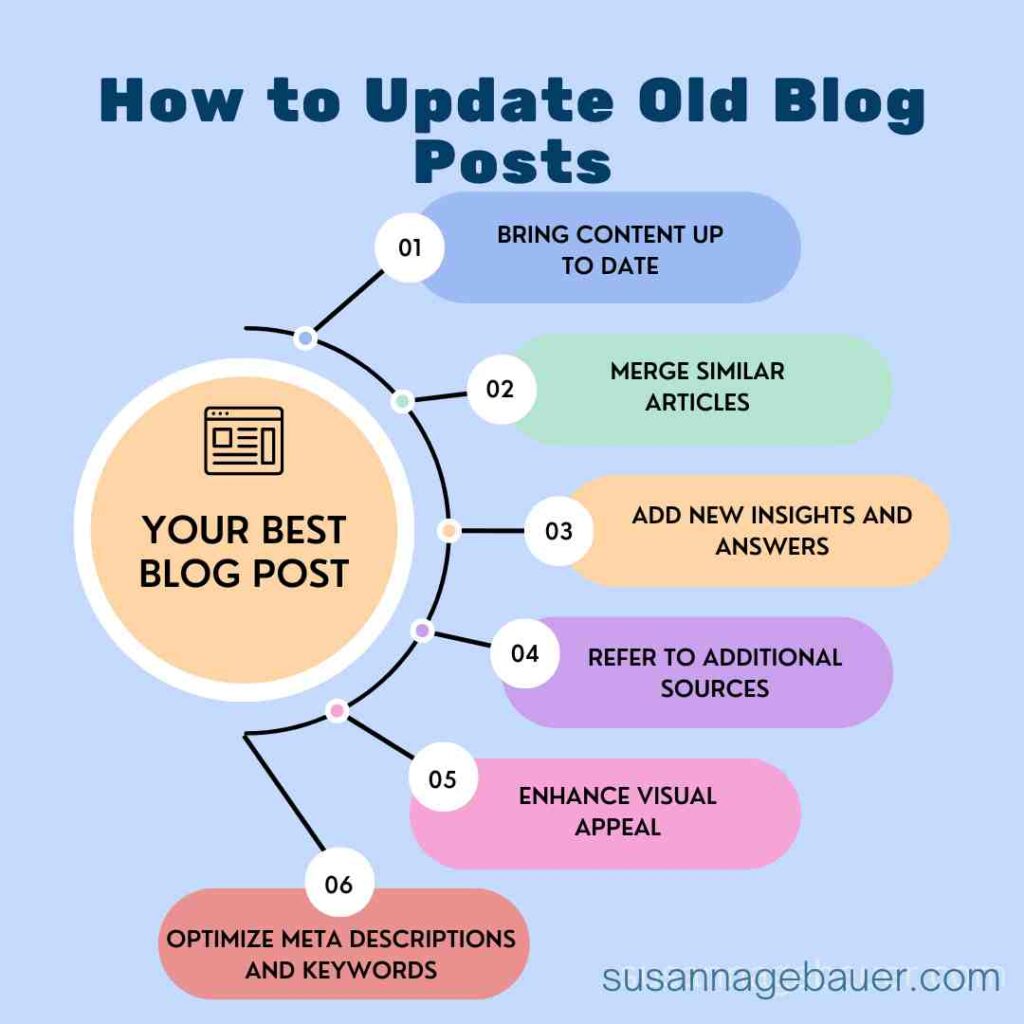
Bring Content Up to Date:
- Update facts, statistics, and examples to reflect the latest information.
- Remove outdated or irrelevant sections to streamline content and improve clarity.
Merge Similar Articles:
- Consolidate multiple articles on similar topics into a single, comprehensive piece.
- This reduces clutter on your website and enhances the depth of your content.
Add New Insights and Answers:
- Incorporate fresh perspectives, best practices, and answers to commonly asked questions.
- Your evolving expertise and audience feedback can enrich existing content.
Refer to Additional Sources:
- Include references to recent studies, research, and case studies to bolster your arguments.
- Citing credible sources adds credibility and depth to your refreshed content.
Enhance Visual Appeal:
- Integrate images, videos, and other visual elements to enhance engagement and comprehension.
- Visuals break up text and make content more digestible for readers.
Optimize Meta Descriptions and Keywords:
- Craft compelling meta descriptions that entice clicks and accurately reflect the content.
- Identify new keywords and optimize existing ones to improve search visibility and click-through rates.
Fine-Tuning Your Updates
- Include Current Year in Titles:
- Adding the current year signals freshness and relevance to readers and search engines alike.
- This simple tactic can boost click-through rates and maintain relevance over time.
- Republishing Old Posts:
- Updating the publication date signals to both readers and search engines that the content is fresh.
- Republishing with a new date can breathe new life into old posts and attract more traffic.
Choosing Which Posts to Update
If you have been blogging for a while, there may be hundreds of blog posts for you to choose from. Which ones are the best candidates to update for new content?
Relevance to Content Pillar:
- Prioritize posts that align closely with your core content themes and audience interests.
- Focus on updating content that drives conversions and engagement.
Lost Traffic Over Time:
- Identify posts that have experienced a decline in traffic or engagement.
- Refreshing these posts can reignite interest and improve search rankings.
Backlink Authority:
- Target posts with a significant number of inbound links to maximize their marketing potential.
- Preserve and enhance the authority of posts that have already garnered backlinks.
Potential for Ranking Improvement:
- Identify posts that are close to ranking higher in search results but need a final push.
- Updates can propel these posts to the top of search rankings and increase organic traffic.
How often should you update your content?
You should not set a schedule for updates to your posts. Update your posts as needed based on changes in information, new and additional knowledge, audience feedback, and performance metrics.
Best Practices for Updating
- Maintain URL Integrity: Avoid changing URLs to preserve existing backlinks and search engine rankings.
- Keyword Considerations: Retain focus keywords in titles and content while exploring new angles and insights.
- Transparency with Readers: Clearly communicate updates to readers with editor’s notes or revision histories.
- Track Performance Metrics: Monitor traffic, engagement, and SEO rankings before and after updates to assess effectiveness.
Updating old blog posts offers many benefits, from improved SEO performance to enhanced user experience. By strategically refreshing your content, you can maintain relevance, attract more traffic, and solidify your authority in your niche.
Don’t let your old blog posts languish in obscurity—give them the attention they deserve and watch your content soar to new heights!
The power of repurposing
Creating content for blogs, social media and newsletters can be daunting, but repurposing existing content offers a solution. Repurposing involves transforming existing content into various formats to extend its reach and effectiveness across multiple platforms.
Content repurposing is a lot more than resharing content on various platforms. It always includes adjusting the content to the new intended purpose:
- Repurposing entails creating new content pieces from existing material, allowing for diverse formats and purposes.
- Repurposing content maximizes the results you derive from the research and knowledge you already did for a piece of content.
- Examples include turning blog posts into email content, Twitter threads, or social media images, among others.
There are multiple benefits of repurposing content in your content creation process:
- Time and Cost Efficiency: Save time and resources by repurposing existing content instead of creating entirely new material.
- Achieve Multiple Goals: Utilize the same content to cater to different audiences and platforms, maximizing reach and engagement.
- Diversify Content Formats: Appeal to various audience preferences by repurposing content into different formats like videos, podcasts, or infographics.
- Reinforce Messaging and Branding: Repurposed content reinforces key messages and helps build brand identity across platforms.
Not every piece of content is good for repurposing. How can you choose the best content for repurposing?
Start by looking at your evergreen and seasonal content. These are ideal candidates for repurposing due to their enduring relevance and versatility. Also, consider what your audience likes and responds to. If people like your content in one outlet they may appreciate it in another form and place.
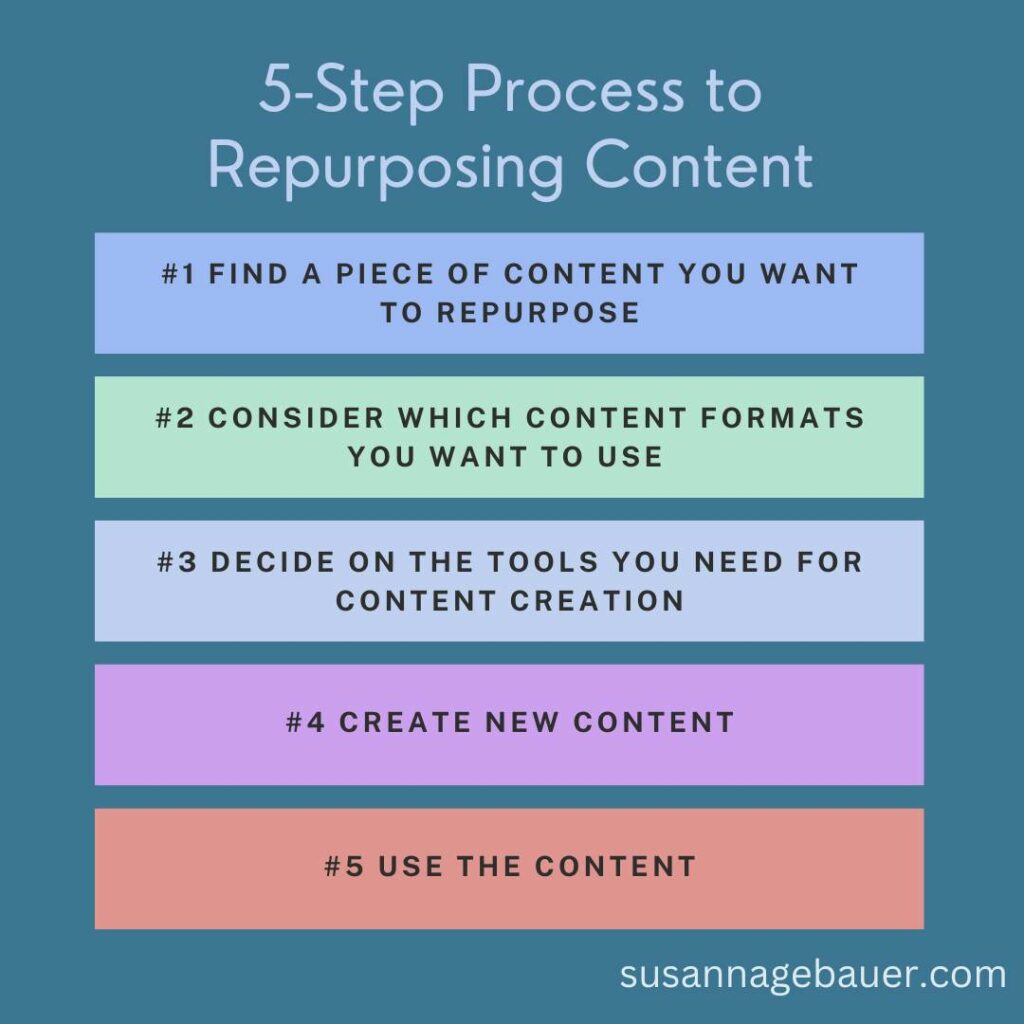
Here is your actionable guide to repurposing content:
- Select high-quality, resonant content to repurpose, ensuring maximum impact.
- Determine suitable content formats based on audience preferences and platform requirements.
- Identify necessary tools for content creation, such as design apps or podcasting software.
- Create new content pieces using existing material, adapting them to fit chosen formats.
- Distribute repurposed content across relevant platforms to maximize visibility and engagement.
Here are some examples of content repurposing:
- Blog Posts: Transform into LinkedIn articles or guest posts, Quora answers, videos, podcasts, infographics, or email newsletters.
- Webinars: Repurpose as videos, blog posts, podcast episodes, or social media snippets.
- Videos: Adapt into blog posts, social media teasers, podcast episodes, or email newsletters.
- Podcasts: Convert into videos, blog posts, social media snippets, or email newsletters.
- Newsletters: Repurpose as social media tips, blog posts, or infographics for wider distribution.
Embrace the vast opportunities offered by content repurposing to extend your reach, engage diverse audiences, and amplify your brand impact across multiple platforms.
Unleashing the power of digital storytelling in your content creation
Digital storytelling is vital for bloggers and brands to forge connections, stand out, and build community with their content. Crafting compelling narratives from everyday experiences can transform your content, add personality, make you more trustworthy, and elevate your brand presence.
Understanding Storytelling:
Storytelling is an art that requires creativity and practice, enabling the communication of ideas and experiences in engaging ways. Digital storytelling involves sharing events and experiences to entertain, educate, and connect with audiences across various platforms.
The Recipe for Effective Storytelling:
- Begin with a captivating introduction to hook your audience.
- Maintain suspense to keep readers engaged.
- Deliver a memorable conclusion that resonates with your audience’s aspirations.
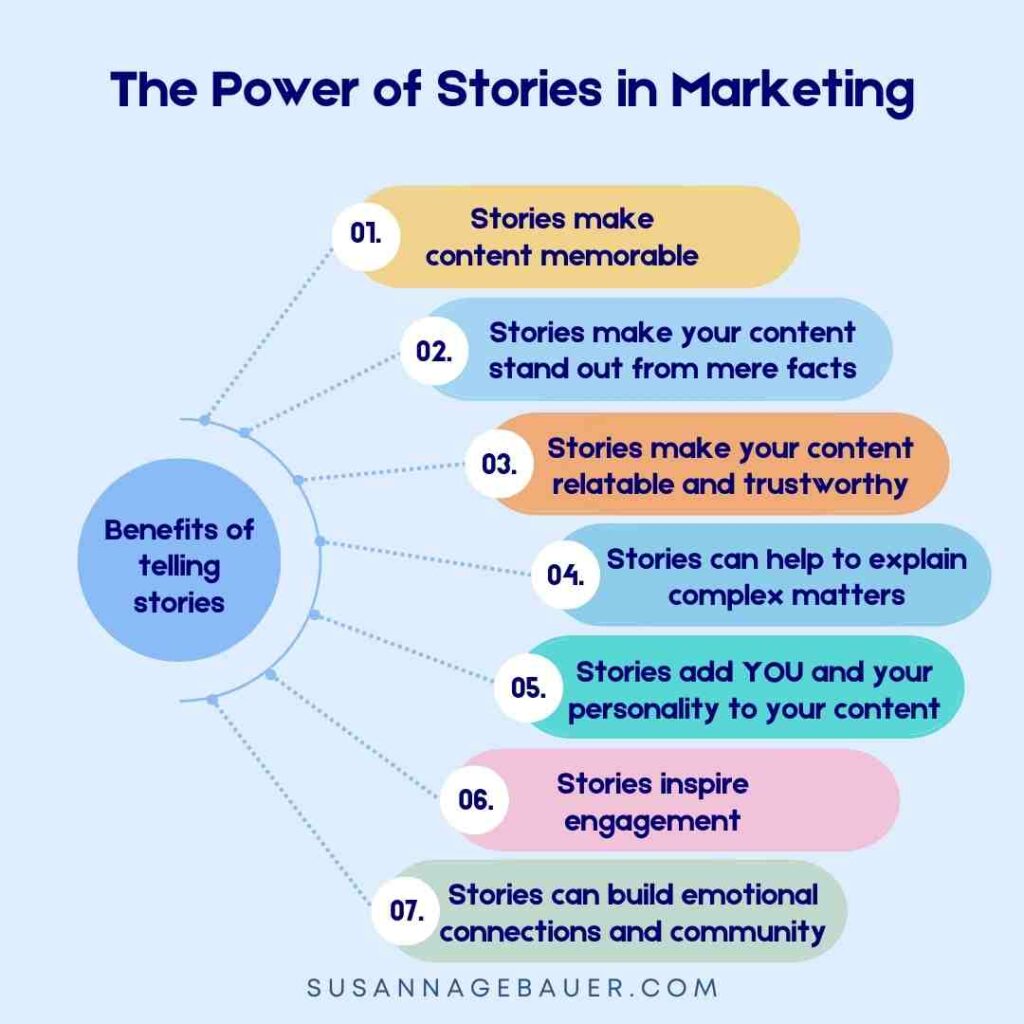
Benefits of Storytelling in Business:
Unique stories make your content stand out, making it memorable and relatable.
Stories enhance believability and authenticity, fostering emotional connections and brand loyalty.
Engaging narratives simplify complex concepts and inspire action, driving long-term engagement and community building.
Storytelling in Various Contexts:
In blogging, personal stories enrich content and contribute to your blogging persona, fostering community engagement.
In marketing, stories evoke emotions and create desire, enhancing brand image and sparking action across sales funnels.
In sales, effective sales stories identify problems, offer solutions, and illustrate transformations. They build trust and drive conversions and revenue growth.
In social media, personal stories humanize your brand and spark conversations. Stories set your content apart in crowded social feeds and help to build community around your posts.
Digital Storytelling Tactics:
- Sneak Peek: Tease your story to build curiosity and anticipation.
- Surprise: Incorporate unexpected plot twists to maintain audience interest.
- Humor: Inject humor to keep readers engaged and entertained.
- Drama: Add excitement and intrigue by infusing your story with dramatic elements.
- Bright Future: Paint a vivid picture of success to inspire action and drive engagement.
- Cliff Hangers: Create suspense by leaving audiences wanting more.
- Villain: Challenge conventions and assumptions to add depth and intrigue to your narrative.
Practice and consume stories to improve your storytelling skills and leverage their transformative potential in your content creation journey.
Business storytelling frameworks
Business storytelling creates emotional connections with your audience, driving engagement and conversions. Business storytelling frameworks can help you to craft captivating stories. These frameworks ensure consistent narratives that capture attention, evoke emotions and guide audiences toward action.
Storytelling frameworks are proven narrative concepts that leverage the power of storytelling to make content memorable, relatable, and trustworthy. Stories engage emotions, synchronize audiences and storytellers, and trigger dopamine release, enhancing memory and connection. Conflict in stories boosts attention and facilitates emotional journeys, making them influential and memorable.
Business storytelling frameworks offer structured approaches to storytelling. Examples of effective storytelling frameworks are
- the Hero’s Journey
- Three-Act Structure
- Freytag’s Pyramid
- StoryBrand
- Pixar Story Framework
- PAS
- CAR
- Thesis-Antithesis-Synthesis
- SCQA
Each framework has its unique elements and applications, empowering storytellers to craft compelling narratives that resonate with audiences.
These frameworks guide storytellers in setting contexts, outlining complications, posing questions, and presenting solutions. They help structure content, clarify messages, and foster engagement. However, effective storytelling relies on authentic, resonant narratives that connect with audiences emotionally.
While frameworks provide structure, storytellers should ensure their narratives remain authentic and engaging. Personal experiences and relatable situations enhance emotional resonance, making stories compelling and memorable. Ultimately, storytellers wield the power to craft narratives that captivate and inspire audiences.
The Power of Emotions in Content Creation
Emotions are a force to be reckoned with. They motivate, inspire, and shape our decisions, making emotional content a potent tool in marketing. Unlike purely factual content, emotional content resonates deeply with audiences, driving engagement, building communities, and boosting sales.
Emotions are complex psychological phenomena that trigger actions and impact our well-being. They can be positive (happiness, love) or negative (anger, sadness, fear), influenced by external events and internal experiences.
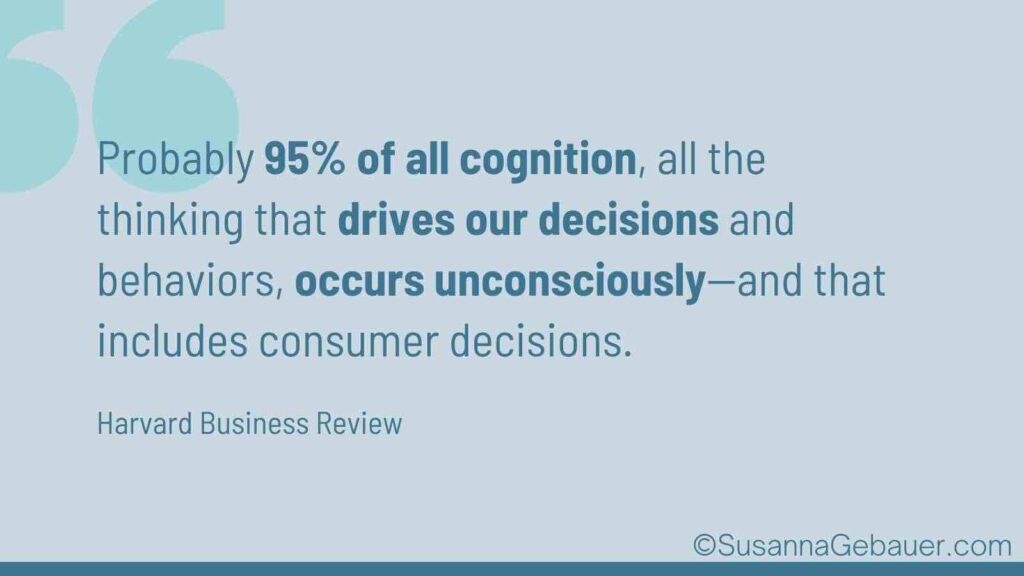
Events, people, and situations can trigger emotions, influencing our behavior and decision-making. Past experiences and personality shape individual emotional responses.
Emotions play a significant role in decision-making, with the subconscious mind often guiding choices. Marketers and content creators must appeal to the emotional mind to effectively influence consumer decisions.
Certain emotions, like fear, anger, joy, and love, exert a profound influence on decision-making. Understanding emotional triggers allows marketers to craft compelling content and drive desired actions.
Harnessing Emotions in Content Marketing:
Content marketing relies on emotional engagement to drive customer action. Emotions trigger reactions and shape perceptions, making emotional storytelling a powerful tool.
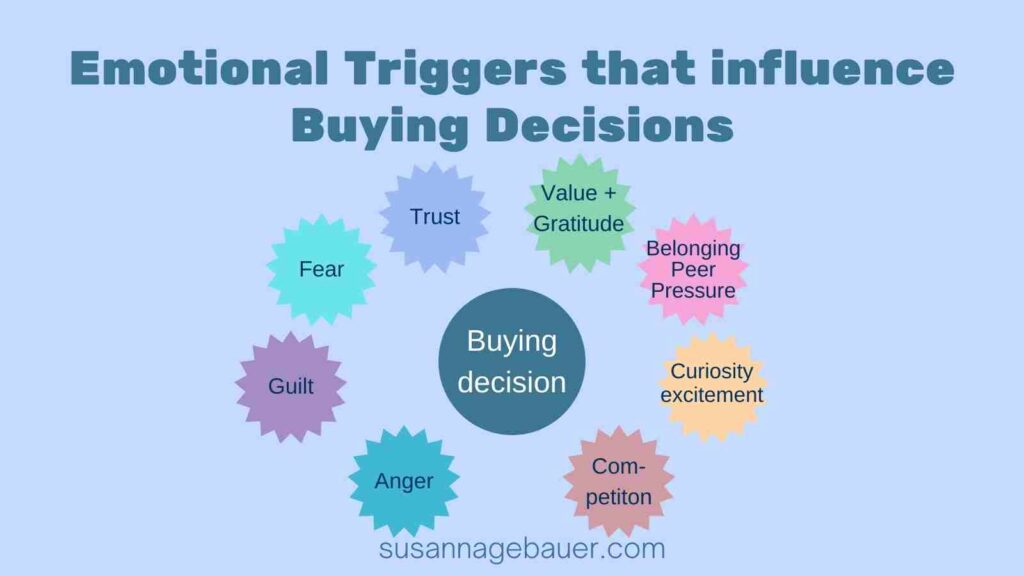
Here are some emotional triggers that have a lot of marketing power:
- Authority: It refers to the power of a leader to make decisions or enforce obedience. It implies legitimacy and the recognition of one’s expertise, position, or knowledge.
- Novelty: People love new stuff. Even though we often cling to the old things, novelty promises to get something we have not had before – and that we often cannot get anywhere else.
- Reciprocity: You can use the reciprocity trigger by giving stuff for free. One day, people start thinking, “I have gotten so much from them, I should buy this one product now.”
- Trust: It is one of the most powerful triggers when it comes to selling. If people don’t trust you they will not buy from you.
Creating Emotional Content:
Crafting emotional content requires authenticity, understanding of the target audience, and strategic use of emotional triggers. Personal stories, emotional marketing words, visuals, and authenticity are key elements of emotional content creation.
How to evoke emotions in your content?
Successful content marketing evokes a range of emotions, from empathy and gratitude to excitement and anticipation. Emotional stories resonate with audiences, driving engagement, building trust, and fostering brand loyalty.
Here is how to evoke emotions:
- Use emotional storytelling
- Use emotional marketing words
- Use visuals
- Be authentic
- Know your audience
- Be genuine
Emotional content is the cornerstone of effective marketing strategies. By understanding and harnessing the power of emotions, marketers can create compelling content that resonates with audiences, drives action, and builds lasting connections.
Overcoming writer’s block: A guide for content creators
Every writer and content creator knows the frustration of staring at a blank page, the cursor blinking relentlessly, taunting us with our inability to form coherent sentences. Writer’s block is the bane of every blogger’s existence, a formidable foe that can strike at any moment. But fear not, for there are ways to conquer this daunting challenge and unleash your creativity once more.
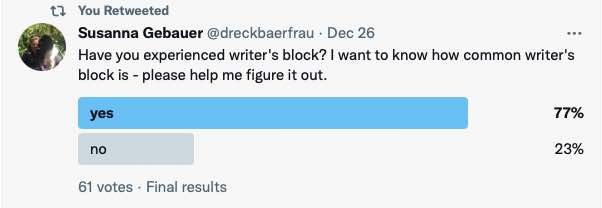
Understanding Writer’s Block
Writer’s block is more than just a lack of inspiration; it’s a mental barrier that prevents us from translating our thoughts into words. Whether it’s a lack of ideas or an overwhelming sense of inadequacy, writer’s block can paralyze even the most seasoned writers.
Identifying the Culprits
Writer’s block can have various reasons:
- Excessive Writing: Sometimes, we exhaust our creative reservoir by churning out too much content, leaving us depleted and uninspired.
- Mental Clutter: A cluttered mind, bogged down by endless to-do lists and worries, can hinder our ability to focus and generate ideas.
- Imposter Syndrome: The fear of not measuring up to our standards or comparing ourselves to others can stifle our creativity and confidence.
Combatting Writer’s Block
If you are stuck in front of a blank page, the worst you can do is to wait for inspiration to come and hope for better days. To overcome writer’s block, we must tackle it head-on:
- Generating Ideas:
- Immerse yourself in your niche community.
- Engage in conversations and glean inspiration from others.
- Peruse blogs and social media for fresh perspectives.
- Maintain a running list of topic ideas to draw from.
- Breaking the Blank Page:
- Start with an outline or subsections to structure your thoughts.
- Begin writing from any section where inspiration strikes, rather than forcing a linear progression.
- Remember, the first draft doesn’t have to be perfect; the goal is to get words on the page.
- Overcoming Doubt:
- Embrace the iterative nature of writing; revisions and improvements are part of the process.
- Take breaks and revisit your work with a fresh perspective.
- Experiment with different writing environments and schedules to optimize productivity.
- Dealing with Burnout:
- Prioritize self-care and take breaks when needed.
- Engage in activities that rejuvenate your mind and spirit.
- Don’t succumb to procrastination; explore alternative creative outlets if writing feels daunting.
Harnessing AI as a content creation tool
While AI can aid in content creation, it should complement, not replace, your unique voice and perspective. Don’t let yourself be fooled into believing that a creative writing prompt can force AI to cough up perfect content that can replace your content creation.
AI-generated content can serve as a springboard for ideas, but you need to infuse it with your personality and insights to maintain authenticity. And never forget to check the facts. AI is a lot like Wikipedia: It may be correct, but often it is not!
Preventing Writer’s Block
Prevention is the best cure for writer’s block:
- Self-Care:
- Schedule regular breaks to recharge your creative batteries.
- Engage in activities that bring you joy and relaxation.
- Explore diverse interests and hobbies to stimulate your mind.
- Optimizing Your Environment:
- Minimize distractions and create a conducive writing atmosphere.
- Experiment with different routines and rituals to find what works best for you.
- Don’t wait for inspiration to strike; cultivate a disciplined approach to writing.
Writer’s block is a formidable adversary, but with perseverance and strategic tactics, it can be overcome. Remember, writing is a journey of exploration and self-discovery. Embrace the challenges, celebrate the victories, and never lose sight of your unique voice amidst the cacophony of words.
I have been creating content for marketing purposes for over 10 years. When I started out, I may have been a little naive. I did not think much about all the technical optimizations of content, the layout or the way I present the content.
But while my content still brought me results, it’s a fact I cannot deny that my content could have brought a lot more success had I known about some of the things I learned in the past years.
This guide is to give you the best start to your content creation and let you fast track to more efficient marketing content.
If there are aspects to content creation, I did not cover in this guide, please let me know, and I will add some more information.

